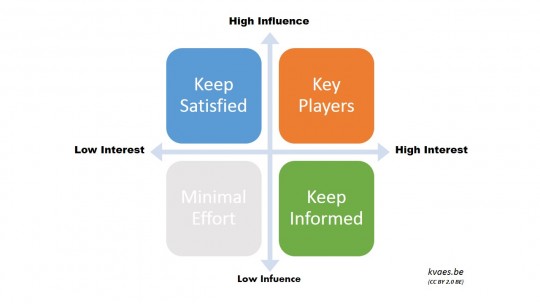

Who are the stakeholders in Project Management?
A Stakeholder is anyone who has an interest in a given project. Everyone involved or affected by a project outcome is considered to be a stakeholder. They could be internal or external: a department, a project sponsor, the project management board, an external entity such as government, or even a third party provider. These are the key players who can drive the business to the next level or cause its downfall.
Why is managing stakeholders so important in project management?
Stakeholder management is about creating long-term relationships based on trust, integrity and customer satisfaction with key players involved in a business on any level. Depending on the way that relationship is managed, the business can experience exponential growth…or its growth could stall or even decline. This is why keeping them satisfied and meeting business requirements’ expectations is vital for a business’ success.
When a Project Manager is doing his job, what he is really doing is ensuring that the expectations of those invested in the project are met. That means having an effective rapport with the parties involved, gaining their trust and approval when necessary, and last but not least, engaging them in the process. When stakeholders are involved in the process, as the project progresses, it makes it easier for the project manager to manage changes and to deliver timely outcomes.
Some of the factors which cause delays in delivering projects outputs include not getting timely feedback from the key players in order to make the right decisions, and scope changes. When the Project Manager keeps the stakeholders involved throughout all the phases of a project, there is a higher chance of delivering timely output. This technique forces the stakeholders to provide feedback on the project and the work in progress so that there are no surprises. There is also more clarity on what is expected, and everyone is on the same page.

Establishing the right communication strategy from the get-go
One of the biggest challenges that projects encounter is when managers fail to communicate key information to the right people at the right time. That is why the first strategic step should be the identification of the project stakeholders. The questions the Project Manager should ask in the identification process are: Who needs to know what? Why and when should that information be communicated to those parties? Who or which department will be affected by the change? Knowing who they are and how a change will impact the business will set the baseline for creating the right communication strategy.
Project managers, take note: effective management of stakeholders is the key for delivering quality output, while at the same meeting the expectation, earning the trust of all partners involved and maintaining long term relationships with clients. Stakeholder’s fulfillment is key to business growth.
Image credits: Innovise, kvaes.be
Sources:
Service Management - Winning "Hearts and Minds"..., Roderick De Guzman, Innovise ESM Blog, 20 February 2012.
Lingo Explained: Stakeholder, Karim Vaes Blog, 12/08/2013.
Article That May Intressed You:
I wonder what are the most effective ways to manage stakeholders' interests?
One way is to include representatives of key stakeholder groups in the project management team.
However, that can create a lot of ambiguity when different stakeholders have contrarian views and interests.
As a consequence, the Steering Committee can become more involved either to find a consensus or to take decision to keep the project on-track. By far not all Steering Committees can cope with these type of tasks due to the day-to-day responsibilities of their members.
Who else experienced similar situations and can share a few ideas?
Edward,
Thank you for your comment. The Governance Body of an enterprise is the entity responsible for achieving stakeholders desired output. Their role is to give clear, concise directions and to monitor management performance to ensure that all processes, development and changes are heading toward the end goal. The enterprise goals are high level strategic ones coming from the top which translate stakeholders needs by using enablers such as: processes, policies and procedures, people resources and IT processes in order to materialize the business objectives. According to COBIT5 which is a framework for the governance and management of the enterprise IT, that is the best way to manage stakeholders needs. In other-words, the enterprise goals are cascaded into IT related goals using the enablers of performance listed above. With that structure there are no rooms for ambiguity, because all the strategic planing for product development already involved stakeholders input and approvals. With that setting each process and tasks owners document and inform management of all aspects of operations and management in turn informs the governing body. Like that everyone stay in the loop and stakeholders needs have a higher chance of achievements. The other logic is simple; If one doesn't know and understand clients needs, and communicate the business strategies to them, how can the business deliver the expected output and keep them satisfied? I hope that helps understanding the rationale behind the fact stakeholder 'satisfaction and engagement are key to business continuity and success.
Carline,
Many thanks for your explanations. I agree that well-defined corporate structures and processes as well as various project management frameworks and tools (if applied properly) help to reduce ambiguity.
However, in my experience, in most businesses there is an inherent level of ambiguity. The reason for this is simple and shouldn't be neglected.
Companies and organizations are made of people and work for people. Every person has a set of interests that can be different from the ones of fellow colleagues, managers, customers, etc.
Working for an organization is also about striking a balance between one's own needs/interests and those of other employees and outside stakeholders.
Projects have a tendency to affect the existing equilibrium of many people within and outside an organization.
Understanding the related dynamics is important at all stages of a project.
In my opinion, Change Management and Project Risk Management start already at the initiation stage of a projects.
Otherwise, it is very difficult to effectively get all relevant people on board.
People who do not support a project but are affected by its outcome are a potential threat to its success. That's at least my experience.
I believe that Project Management as a discipline is as much about managing people as it is about managing processes and applying proven techniques and frameworks.